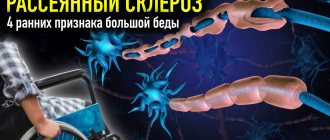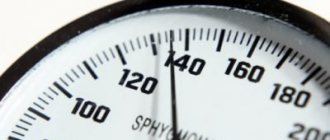Clinical picture of cerebrovascular disease
When blockage of blood vessels occurs, caused by unfavorable factors, a pathology occurs in which the capacity of the vessels is reduced, thereby reducing the supply of nutrients necessary for normal brain function. In humans, blood vessels consist of three layers, each of which performs specific functions.
The inner layer consists of epithelial cells that ensure the free passage of blood inside the vessel. The middle layer consists of elastic cells and muscle fibers that prevent blood from spreading outside the vessel. The third layer, the outer layer, is responsible for separating the vessels from the surrounding tissues.
Blockage of blood vessels in the brain occurs due to the accumulation of cholesterol plaques , gradually their number increases and begins to interfere with the free passage of blood flow, blood circulation decreases, and the vessel loses its elastic mobility due to a decrease in the elasticity of the inner layer, which contributes to the destruction of the integrity of the bloodstream. vessel and the formation of blood clots.
Long-term blockage of cerebral vessels can cause the development of dyscirculatory encephalopathy, or lead to insufficient blood supply, which can lead to hemorrhage or stroke.
There are more and more people diagnosed with blockage of blood vessels in the brain every year; the reasons for the manifestation of this disease are the consumption of fatty foods, alcohol abuse, nicotine and poor diet. The accumulation of cholesterol plaques or Atherosclerosis affects the largest vessels responsible for the blood supply to the brain.
Chronic arterial hypertension also leads to deformation and blockage of brain vessels. In many cases, these are two main factors in the narrowing of blood vessels in the brain.
Causes of the disease
Cerebral embolism appears in patients when exposed to a number of provoking factors:
- Drinking insufficient water . If the drinking regime is violated, the viscosity of the blood increases. This leads to disruption of normal blood flow.
- Genetic predisposition . People whose relatives suffered from the disease are at risk.
- Stressful situations . With the constant experience of positive and negative emotions, patients develop illness.
- Bad habits . When the body is exposed to nicotine, alcohol and drugs, a person’s blood thickens, which leads to an increased risk of thrombosis. When blood vessels become clogged, they become sluggish, lose elasticity, and form plaques.
- The predominance in the diet of foods that contain fats and carbohydrates in large quantities . With improper nutrition, waste appears in the blood, and plaques appear on the walls of blood vessels.
- Physical inactivity . With insufficient physical activity and a sedentary lifestyle, circulation and free flow of blood through the vessels are disrupted.
Pathology is diagnosed for a variety of diseases. People who suffer from varicose veins are at risk. The disease develops in patients with thrombophlebitis. Insufficiency of blood coagulation function becomes the cause of pathology. The cause of the disease is atherosclerosis. The likelihood of developing the disease increases in people with diabetes mellitus or autoimmune vascular changes .
With obesity and impaired metabolism, patients are diagnosed with the disease. During pregnancy, there may be an increase in blood clotting, which leads to illness. It develops if a large amount of substances is released in the patient's body, which leads to blood thickening. If a person takes certain medications, this leads to pathology.
Blockage of blood vessels in the brain is observed during diseases in the human body and exposure to various provoking environmental factors.
Symptoms of blockage of blood vessels in the brain
The disease occurs in two scenarios: acute, which includes the occurrence of a stroke, which, without timely assistance, leads to the death of the patient, and according to the chronic course of the disease, which lasts for several years. A person can get used to the symptoms of the chronic form and eventually stop noticing them.
The chronic course of the disease of blockage of blood vessels in the brain has three stages:
- With the first, the elasticity of the walls of blood vessels begins to decrease, which causes headaches, irritability appears, concentration decreases and fatigue increases.
- At the second stage, the symptoms of the disease intensify, often accompanied by tinnitus and sleep disturbances or insomnia. All together, this leads to memory impairment, fainting, prolonged migraines, disruption of the musculoskeletal system, and possible false urge to urinate. Sometimes a patient with blockage of cerebral vessels experiences visual impairment and sensitivity in the extremities.
- The third stage is the most distinct in terms of symptoms; as it develops, it becomes difficult for the patient to move, coordination of movements is lost, and mental ability is inhibited. Due to disturbances in brain activity, a person may experience uncontrolled urination and defecation.
In the third stage, the patient needs constant assistance, as he almost completely loses his ability to work and cannot control his actions. Failure to provide assistance at this stage of the disease often leads to immobility of the patient.
Disease prevention
To prevent blockage of blood vessels in the brain, a healthy diet is recommended; you should exclude foods high in fat and salt from your daily diet. Eat vegetables and fruits more often, because the acids they contain contribute to the breakdown of fats. Provide your body with constant physical activity, stop smoking, and reduce the consumption of strong alcohol. And also avoid stress or reduce its impact on your nervous system.
Blockage of blood vessels in the brain, the symptoms of which are specific, is accompanied by disruption of the nervous system. Oxygen starvation of tissues leads to the appearance of areas of ischemia and necrosis. The consequences of such complications vary, including the death of the patient. Therefore, vascular blockages need to be identified and treated promptly.
Diagnosis of the disease
Diagnosis of the disease must be done in several directions. A neurologist examines neurological symptoms, assessing the degree of mental activity of the patient and reflexes. To assess the severity of the disease and the accuracy of the diagnosis, the doctor needs the help of relatives who observe the patient’s behavior at home.
ECG and computed tomography of the brain, along with Doppler sonography and computed tomography, are among the most important tools in identifying the disease. They allow you to find out the speed of blood flow, the presence of blood clots, aneurysms and atherosclerotic plaques in the vessels.
Causes
The following factors lead to a decrease in the patency of cerebral vessels:
- Sedentary lifestyle. Sedentary work contributes to impaired blood flow.
- Poor nutrition. Eating fatty and fried foods leads to the accumulation of cholesterol plaques that block the lumens of blood vessels.
- Bad habits. Drinking alcohol, drug addiction and smoking lead to narrowing of the arteries, impairing blood supply to brain tissue.
- Non-compliance with drinking regime. A lack of fluid in the body leads to thickening of the blood and slower blood flow.
- Prolonged psycho-emotional overload.
- Genetic predisposition. Anomalies in the structure of blood vessels and chronic diseases of the circulatory system are transmitted from parents, leading to deterioration of cerebral circulation.
- Metabolic disease.
- Inflammatory processes in the walls of blood vessels, accompanied by the formation of blood clots.
- Pregnancy. During pregnancy, blood clotting increases and various pathologies of internal organs worsen, leading to a slowdown in blood flow.
- Crash syndrome. This is the name of a pathological condition caused by the release of a large amount of toxic tissue breakdown products. Poisoning of the body due to burns, cancer and purulent infectious lesions is accompanied by intravascular coagulation.
- Autoimmune diseases, atherosclerotic lesions of cerebral vessels, septicemia, decompensated diabetes mellitus.
- Post-traumatic complications. When soft tissues and blood vessels are damaged, arteries and veins become clogged with fat particles.
- Taking medications that increase blood clotting (hemostatics, hormonal contraceptives).
- Traumatic brain injuries, bruises of soft tissues of the head.
- Embolism of cerebral arteries. Occurs when air enters the blood during intravenous and intra-arterial injections and infusions.
Treatment methods for blockage of blood vessels in the brain
When treating blockage of cerebral vessels, one must proceed from the clinical picture (stage of the disease). The acute form of the disease requires immediate intervention by specialists and the prescription of medications that reduce or eliminate the symptoms of the disease. With this form, rapid blockage of blood vessels , which will lead to irreversible consequences in the human brain.
Detection of the disease in the chronic stage requires the appointment of therapy and complex treatment from cardiologists, therapists, and angioneurologists. At this stage, the patient’s cure depends on the patient’s compliance with all procedures and on correctly selected drug therapy. In particularly difficult cases, drug treatment can last a lifetime.
If there is no positive effect after taking medications, surgical intervention . The purpose of the surgical intervention is to restore healthy blood flow into the vessel; for this, bypass surgery or endarterectomy is performed.
During bypass surgery, a special stent is inserted into the patient’s vessel, which opens the normal flow of blood into the vessels of the brain. And with endarterectomy, atherosclerotic plaques are removed.
Diagnostic measures
If vascular blockage is suspected, an assessment of the medical history and symptoms is not enough. Therefore, it is recommended to use instrumental methods:
- CT scan. This is an x-ray examination that examines the structural elements of the brain. The method detects the location and size of the pathology.
- Angiography . This is an x-ray examination that provides the ability to assess the quality of blood filling of blood vessels. The method determines the time and sequence of filling the vascular system with blood, the places where the blood flow is changed due to narrowing or blockage of the lumen channel.
- Magnetic resonance imaging. It is a full-scale analysis of the structure of brain tissue and blood vessels. The research method determines deviations from the norm that cause abnormal changes.
- Ultrasonography. Patients are recommended to undergo duplex scanning of the cervical and intracerebral canals. To study the movement of blood in large canals, Doppler sonography is recommended.
Using echotomography, deep internal tissues are examined. Transcranial Dopplerography allows you to examine the blood flow in the intracranial vessels.
- Neurosonography . Using this method, the state of the brain and its structure in young children is assessed before the fontanel on the head closes. Through it, the vascular network is examined using an ultrasound machine.
Consequences
The most common complications of cerebral embolism include:
- Movement disorders. Deterioration of the blood supply to the cranial nerves can disrupt swallowing processes. Because of this, the patient has to be fed through a tube. No less dangerous are paralysis of the muscles of the legs and arms, which make a person disabled.
- Speech impairment.
- Decreased intellectual and cognitive abilities. The psycho-emotional state also changes: the patient becomes aggressive, irritable and hot-tempered.
How to treat
For blockage of cerebral vessels, treatment involves the use of the following methods:
- Lifestyle changes. The patient must give up bad habits and start eating right. It is important to remain physically active, but excessive exercise during illness is contraindicated.
- Drug treatment. Drugs are prescribed to help eliminate associated disorders and restore blood flow. Statins (Rosuvastatin) break down and remove cholesterol, reducing the severity of atherosclerosis. Fibrates (Amotril) dissolve atherosclerotic deposits. These drugs are not recommended for use in combination with statins. Drugs that improve blood flow (Actovegin) help restore nutrition to brain tissue. Antispasmodics (Drotaverine) dilate blood vessels, restoring blood circulation.
- Surgical interventions. Used when conservative therapy is ineffective. The operation helps restore blood flow to the cerebral arteries. When bypassing, artificial prostheses are used to create a bypass path. Endarterectomy involves dissection and cleansing of the vessel from atherosclerotic deposits and blood clots that appear during thromboembolism.
- Using folk recipes. For vascular diseases, tinctures of walnuts, hawthorn and immortelle are effective. 50 g of raw material is poured with 0.5 liters of alcohol and left for 2 weeks. The finished product is taken 20 drops 3 times a day.
How to clean blood vessels effectively with folk remedies - recipes and prevention
Today there are a lot of recommendations on how to clean blood vessels using folk remedies and methods of official medicine.
Of course, in the case when the disease is advanced and is in an acute phase, no folk or home methods will help and you should immediately consult a doctor.
But as a preventative measure, restoring the condition of blood vessels and preventing the development of pathologies, you can follow tips on how to clean blood vessels with folk remedies at home.
- First of all, you should change your diet and reduce as much as possible the amount of fatty foods and dishes that increase blood cholesterol levels. The amount of salt, sugar, spicy and smoked foods consumed is also reduced.
- Increase the consumption of fresh vegetables and fruits, cereals, thanks to which blood vessels are cleansed, toxins and wastes are removed from the body, the level of immunity and protection increases, and any organ is cleansed.
- If you are overweight, this pathology also negatively affects the condition of blood vessels. Contact a professional nutritionist who will develop an individual diet for you, thanks to which you will improve your well-being, get rid of extra pounds, and restore the elasticity of your blood vessels.
How to effectively clean blood vessels using folk remedies: examples of recipes:
- Using garlic . This vegetable is a very effective aid in cleaning blood vessels. You need to take about 150 g of peeled garlic, chop it and pour alcohol or vodka (150 ml). Place this composition in a glass container, close it tightly and leave in a dark place for 10 days. After this period ends, strain the composition through cheesecloth and store your folk remedy in the refrigerator. You should take 20 drops of the infusion, diluted in half a glass of water 20 minutes before meals, three times a day. The course of treatment is 1 month.
- Rosehip is also effective in combating blockage of blood vessels. It is enough to pour 2 tablespoons of boiling water. dried rose hips, leave for 6 hours in a thermos and drink this drink 1 liter per day for 1 month.
- Walnuts and tincture of this healthy product help cleanse blood vessels and strengthen their walls. For the tincture, take 1 glass of walnut partitions, pour a glass of vodka over them and infuse the composition for 2 weeks in a dark place. Three times a day for 2 weeks, dilute 50 ml of water with 20 drops of tincture and consume, regardless of meals.










